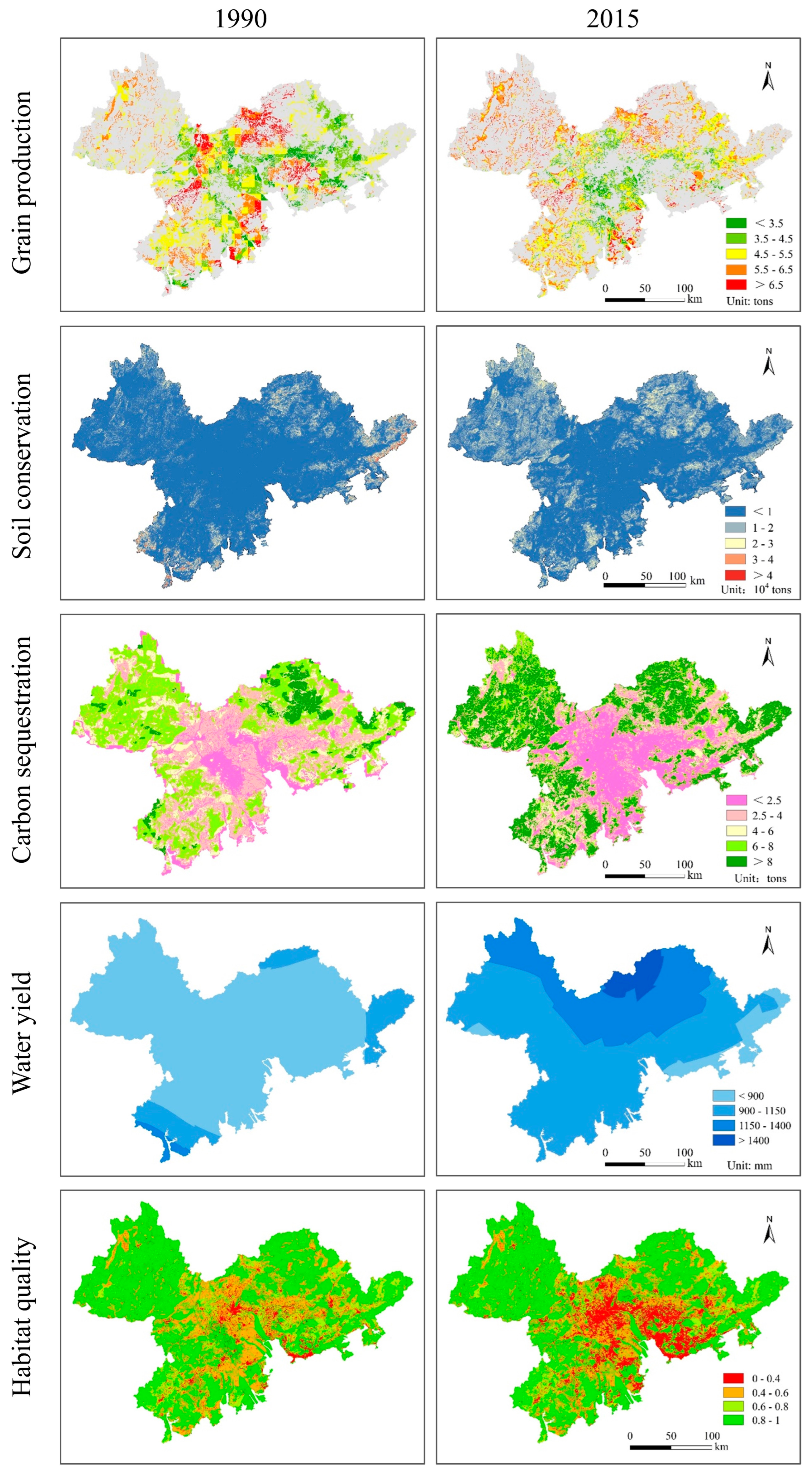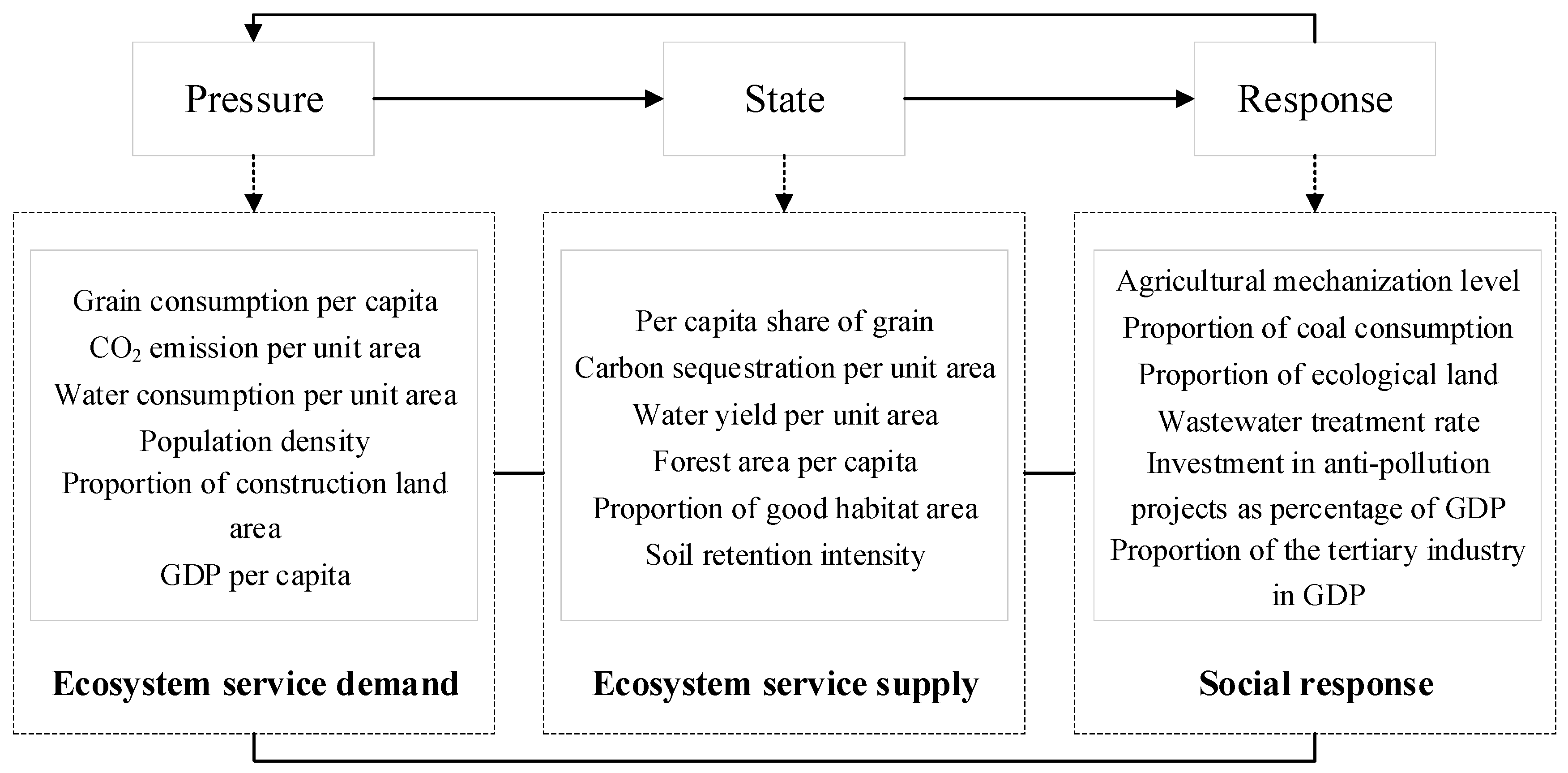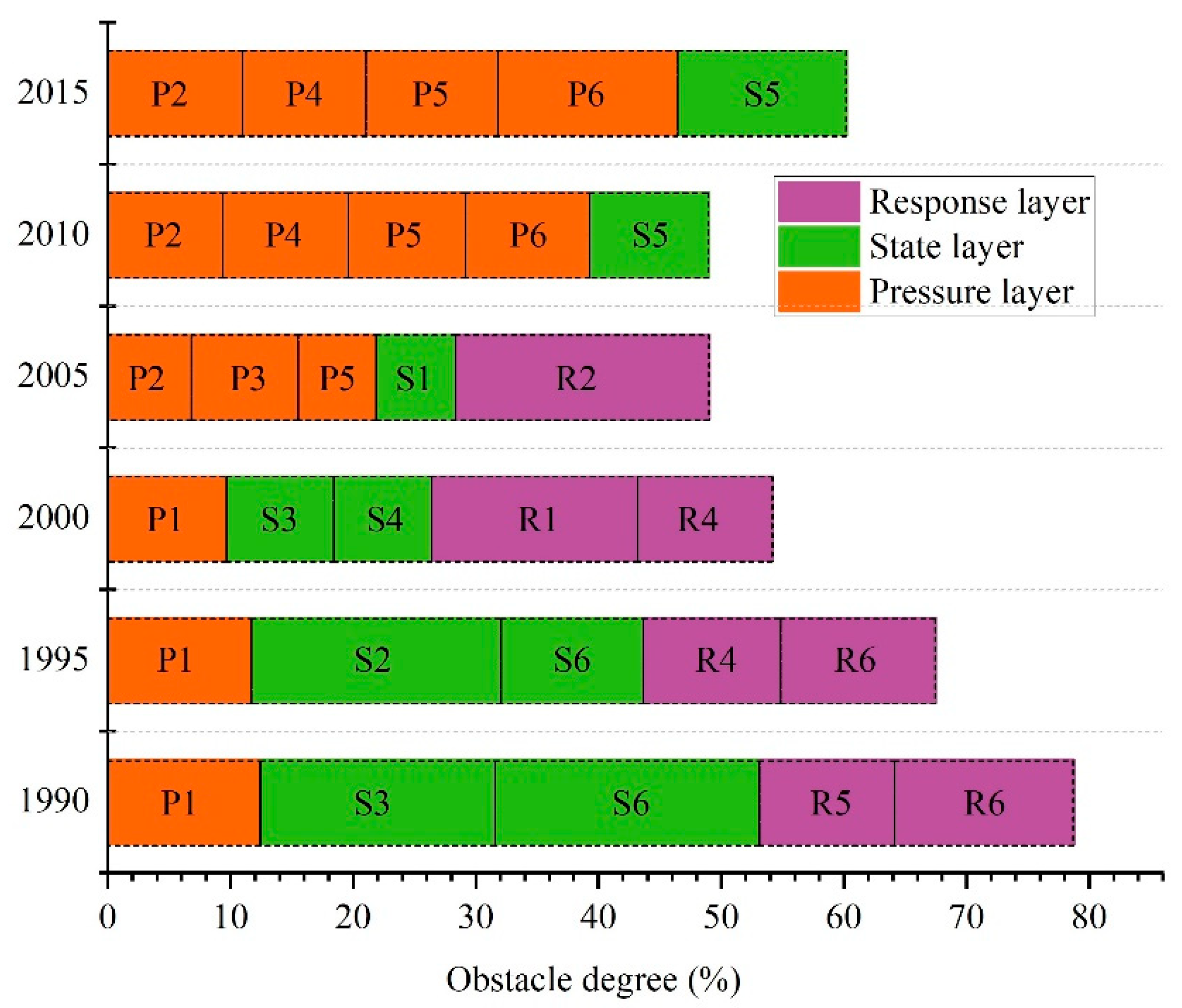Linking Ecosystem Service Supply and Demand to Evaluate the Ecological Security in the Pearl River Delta Based on the Pressure-State-Response Model
Abstract
1. Introduction
2. Materials and Methods
2.1. Study Area
2.2. Data Sources and Processing
2.3. Methods
2.3.1. Ecosystem Service Supply Evaluation
2.3.2. Ecosystem Service Demand Evaluation
2.3.3. Ecological Security Evaluation
2.3.4. Obstacle Factor Identification
3. Results
3.1. Ecosystem Service Supply from 1990 to 2015 in the Pearl River Delta
3.2. Ecosystem Service Demand from 1990 to 2015 in the Pearl River Delta
3.3. Change Trends of the Ecological Security in the Pearl River Delta from 1990 to 2015
3.3.1. Pressure Index
3.3.2. State Index
3.3.3. Response Index
3.3.4. Ecological Security Index
3.4. Identification of Key Obstacle Factors
4. Discussion
4.1. Evolution of Ecological Security
4.2. Evolution of Obstacle Factors and Policy Implications
4.3. Limitations and Prospects
5. Conclusions
Author Contributions
Funding
Institutional Review Board Statement
Informed Consent Statement
Data Availability Statement
Conflicts of Interest
Appendix A


References
- Feng, Y.; Yang, Q.; Tong, X.; Chen, L. Evaluating land ecological security and examining its relationships with driving factors using GIS and generalized additive model. Sci. Total Environ. 2018, 633, 1469–1479. [Google Scholar] [CrossRef] [PubMed]
- Huang, H.; Chen, B.; Ma, Z.; Liu, Z.; Zheng, S.; Yu, W.; Liao, J.; Hu, W.; Du, J.; Chen, G. Assessing the ecological security of the estuary in view of the ecological services-A case study of the Xiamen Estuary. Ocean Coast. Manag. 2017, 137, 12–23. [Google Scholar]
- Dobson, A.P.; Bradshaw, A.D.; Baker, A.J. Hopes for the future: Restoration ecology and conservation biology. Science 1997, 277, 515–522. [Google Scholar] [CrossRef]
- Yu, G.; Zhang, S.; Yu, Q.; Fan, Y.; Zeng, Q.; Wu, L.; Zhou, R.; Nan, N.; Zhao, P. Assessing ecological security at the watershed scale based on RS/GIS: A case study from the Hanjiang River Basin. Stoch. Environ. Res. Risk Assess. 2014, 28, 307–318. [Google Scholar] [CrossRef]
- Gong, J.; Liu, Y.; Xia, B.; Zhao, G. Urban ecological security assessment and forecasting, based on a cellular automata model: A case study of Guangzhou, China. Ecol. Model. 2009, 220, 3612–3620. [Google Scholar] [CrossRef]
- Bartel, A. Analysis of landscape pattern: Towards a ‘top down’ indicator for evaluation of landuse. Ecol. Model. 2000, 130, 87–94. [Google Scholar] [CrossRef]
- Zhao, Y.; Zou, X.; Cheng, H.; Jia, H.; Wu, Y.; Wang, G.; Zhang, C.; Gao, S. Assessing the ecological security of the Tibetan plateau: Methodology and a case study for Lhaze County. J. Environ. Manag. 2006, 80, 120–131. [Google Scholar] [CrossRef]
- Ke, X.; Wang, X.; Guo, H.; Yang, C.; Zhou, Q.; Mougharbel, A. Urban ecological security evaluation and spatial correlation research—Based on data analysis of 16 cities in Hubei Province of China. J. Clean. Prod. 2021, 311, 127613. [Google Scholar] [CrossRef]
- Gao, P.P.; Li, Y.P.; Sun, J.; Li, H.W. Coupling fuzzy multiple attribute decision-making with analytic hierarchy process to evaluate urban ecological security: A case study of Guangzhou, China. Ecol. Complex. 2018, 34, 23–34. [Google Scholar] [CrossRef]
- Chu, X.; Deng, X.; Jin, G.; Wang, Z.; Li, Z. Ecological security assessment based on ecological footprint approach in Beijing-Tianjin-Hebei region, China. Phys. Chem. Earth 2017, 101, 43–51. [Google Scholar] [CrossRef]
- Fu, B.; Liang, D.; Lu, N. Landscape ecology: Coupling of pattern, process, and scale. Chin. Geogr. Sci. 2011, 21, 385–391. [Google Scholar] [CrossRef]
- Liu, X.; Wang, X.; Song, J.; Wang, H.; Wang, S. Indirect carbon emissions of urban households in China: Patterns, determinants and inequality. J. Clean. Prod. 2019, 241, 118335. [Google Scholar] [CrossRef]
- Hu, M.; Li, Z.; Yuan, M.; Fan, C.; Xia, B. Spatial differentiation of ecological security and differentiated management of ecological conservation in the Pearl River Delta, China. Ecol. Indic. 2019, 104, 439–448. [Google Scholar] [CrossRef]
- Zhang, M.; Ao, Y.; Liu, M.; Zhao, Y.; Lin, K.; Cheng, T. Ecological security assessment based on ecosystem service value and ecological footprint in the Pearl River Delta urban agglomeration, China. Ecol. Indic. 2022, 144, 109528. [Google Scholar] [CrossRef]
- Wang, X.; Lyu, Y.; Fu, B. Ecosystem services and ecological security. Chin. J. Nat. 2012, 34, 273–276. (In Chinese) [Google Scholar]
- Yu, Z.; Bi, H. The key problems and future direction of ecosystem services research. Energy Procedia 2011, 5, 64–68. [Google Scholar] [CrossRef]
- Zhang, L.; Peng, J.; Liu, Y.; Wu, J. Coupling ecosystem services supply and human ecological demand to identify landscape ecological security pattern: A case study in Beijing–Tianjin–Hebei region, China. Urban Ecosyst. 2017, 20, 701–714. [Google Scholar] [CrossRef]
- Lyu, X.; Li, X.; Wang, K.; Cao, W.; Gong, J.; Wang, H.; Lou, A. Linking regional sustainable development goals with ecosystem services to identify ecological security patterns. Land Degrad. Dev. 2022, 33, 3841–3854. [Google Scholar] [CrossRef]
- Li, Z.; Li, M.; Xia, B. Spatio-temporal dynamics of ecological security pattern of the Pearl River Delta urban agglomeration based on LUCC simulation. Ecol. Indic. 2020, 114, 106319. [Google Scholar] [CrossRef]
- Kuri, F.; Murwira, A.; Murwira, K.S.; Masocha, M. Predicting maize yield in Zimbabwe using dry dekads derived from remotely sensed Vegetation Condition Index. Int. J. Appl. Earth Obs. 2014, 33, 39–46. [Google Scholar] [CrossRef]
- Kinnell, P.I.A. Event soil loss, runoff and the Universal Soil Loss Equation family of models: A review. J. Hydrol. 2010, 385, 384–397. [Google Scholar] [CrossRef]
- Wang, C.; Wang, L.; Zhan, J.; Liu, W.; Teng, Y.; Chu, X.; Wang, H. Spatial heterogeneity of urbanization impacts on ecosystem services in the urban agglomerations along the Yellow River, China. Ecol. Eng. 2022, 182, 106717. [Google Scholar] [CrossRef]
- Jia, X.; Fu, B.; Feng, X.; Hou, G.; Liu, Y.; Wang, X. The trade-off and synergy between ecosystem services in the Grain-for-Green areas in Northern Shaanxi, China. Ecol. Indic. 2014, 43, 103–113. [Google Scholar] [CrossRef]
- Liu, W.; Zhan, J.; Zhao, F.; Wang, C.; Chang, J.; Asiedu Kumi, M.A.; Leng, M. Scale Effects and Time Variation of Trade-Offs and Synergies among Ecosystem Services in the Pearl River Delta, China. Remote Sens. 2022, 14, 5173. [Google Scholar] [CrossRef]
- Zhao, Y.; Wang, N.; Luo, Y.; He, H.; Wu, L.; Wang, H.; Wang, Q.; Wu, J. Quantification of ecosystem services supply-demand and the impact of demographic change on cultural services in Shenzhen, China. J. Environ. Manag. 2022, 304, 114280. [Google Scholar] [CrossRef]
- Shan, Y.; Liu, J.; Liu, Z.; Xu, X.; Shao, S.; Wang, P.; Guan, D. New provincial CO2 emission inventories in China based on apparent energy consumption data and updated emission factors. Appl. Energ. 2016, 184, 742–750. [Google Scholar] [CrossRef]
- Zhan, J.; Liu, W.; Wu, F.; Li, Z.; Wang, C. Life cycle energy consumption and greenhouse gas emissions of urban residential buildings in Guangzhou city. J. Clean. Prod. 2018, 194, 318–326. [Google Scholar] [CrossRef]
- Lundberg, K.; Balfors, B.; Folkeson, L. Framework for environmental performance measurement in a Swedish public sector organization. J. Clean. Prod. 2009, 17, 1017–1024. [Google Scholar] [CrossRef]
- He, D.; Hou, K.; Wen, J.F.; Wu, S.Q.; Wu, Z.P. A coupled study of ecological security and land use change based on GIS and entropy method—A typical region in Northwest China, Lanzhou. Environ. Sci. Pollut. Res. 2022, 29, 6347–6359. [Google Scholar] [CrossRef] [PubMed]
- Chen, M.; Zheng, L.; Zhang, D.; Li, J. Spatio-Temporal Evolution and Obstacle Factors Analysis of Tourism Ecological Security in Huanggang Dabieshan UNESCO Global Geopark. Int. J. Environ. Res. Public Health 2022, 19, 8670. [Google Scholar] [CrossRef]
- Fan, Y.; Fang, C. Evolution process and obstacle factors of ecological security in western China, a case study of Qinghai province. Ecol. Indic. 2020, 117, 106659. [Google Scholar] [CrossRef]
- Li, Z.; Yuan, M.; Hu, M.; Wang, Y.; Xia, B. Evaluation of ecological security and influencing factors analysis based on robustness analysis and the BP-DEMALTE model: A case study of the Pearl River Delta urban agglomeration. Ecol. Indic. 2019, 101, 595–602. [Google Scholar] [CrossRef]
- Wen, J.; Hou, K. Research on the progress of regional ecological security evaluation and optimization of its common limitations. Ecol. Indic. 2021, 127, 107797. [Google Scholar] [CrossRef]




| Year | Arable Land (Unit: km2) | Forest Land (Unit: km2) | Grassland (Unit: km2) | Water Bodies (Unit: km2) | Construction Land (Unit: km2) | Other Land (Unit: km2) |
|---|---|---|---|---|---|---|
| 1990 | 15,775.79 | 29,985.38 | 1097.10 | 3382.41 | 2908.48 | 171.26 |
| 1995 | 13,084.41 | 30,218.52 | 1392.18 | 3832.62 | 4654.75 | 143.88 |
| 2000 | 14,301.38 | 29,699.66 | 1049.95 | 3999.70 | 4168.85 | 102.85 |
| 2005 | 12,998.94 | 29,333.94 | 980.14 | 3866.22 | 6030.80 | 112.87 |
| 2010 | 12,574.05 | 29,187.31 | 945.08 | 3780.23 | 6722.40 | 114.94 |
| 2015 | 12,420.10 | 28,788.97 | 1072.50 | 3458.54 | 7482.80 | 104.41 |
| Ecosystem Service | Methods | Algorithms 1 | Reference |
|---|---|---|---|
| Grain production | VCI | [20] | |
| Soil conservation | RUSLE | [21] | |
| Carbon sequestration | CASA | [22] | |
| Water yield | Water balance model | [23] | |
| Habitat quality | InVEST | [24] |
| Dimensions | Index | Code | Unit | Attributes | Weight |
|---|---|---|---|---|---|
| Pressure 0.321 | Grain consumption per capita | P1 | kg/capita | − | 0.0519 |
| CO2 emissions per unit area | P2 | t/km2 | − | 0.0536 | |
| Water consumption per unit area | P3 | 104 m3/km2 | − | 0.0482 | |
| Population density | P4 | capita/km2 | − | 0.0523 | |
| Proportion of construction land area | P5 | % | − | 0.0530 | |
| GDP per capita | P6 | RMB/capita | − | 0.0613 | |
| State 0.347 | Per capita share of grain | S1 | kg/capita | + | 0.0481 |
| Carbon sequestration per unit area | S2 | tons/km2 | + | 0.0601 | |
| Water yield per unit area | S3 | 104 m3/km2 | + | 0.0630 | |
| Forest area per capita | S4 | m2/capita | + | 0.0489 | |
| Proportion of good habitat area | S5 | % | + | 0.0590 | |
| Soil retention intensity | S6 | tons/km2 | + | 0.0681 | |
| Response 0.332 | Agricultural mechanization level | R1 | kw/km2 | + | 0.0534 |
| Proportion of coal consumption | R2 | % | − | 0.0774 | |
| Proportion of ecological land | R3 | % | + | 0.0454 | |
| Wastewater treatment rate | R4 | % | + | 0.0496 | |
| Investment in anti-pollution projects as percentage of GDP. | R5 | % | + | 0.0516 | |
| Proportion of the tertiary industry in GDP. | R6 | % | + | 0.0551 |
| Ecosystem Service | 1990 | 1995 | 2000 | 2005 | 2010 | 2015 |
|---|---|---|---|---|---|---|
| Grain production (million tons) | 6.98 | 5.67 | 5.53 | 3.80 | 3.22 | 3.47 |
| Soil retention (billion tons) | 24.30 | 36.58 | 39.07 | 41.13 | 37.32 | 42.13 |
| Carbon sequestration (million tons) | 91.45 | 74.32 | 111.43 | 92.60 | 98.38 | 101.59 |
| Water yield (billion tons) | 41.8 | 56.2 | 58.5 | 71.6 | 65.0 | 63.6 |
| Habitat quality | 0.7738 | 0.7679 | 0.7670 | 0.7465 | 0.7365 | 0.7234 |
| Ecosystem Service | 1990 | 1995 | 2000 | 2005 | 2010 | 2015 |
|---|---|---|---|---|---|---|
| Grain demand (million tons) | 5.75 | 6.22 | 7.88 | 7.14 | 7.27 | 6.33 |
| Carbon emission (million tons) | 69.90 | 197.43 | 245.88 | 444.55 | 502.26 | 607.72 |
| Water demand (billion tons) | 19.42 | 19.53 | 26.87 | 33.56 | 27.41 | 22.82 |
Disclaimer/Publisher’s Note: The statements, opinions and data contained in all publications are solely those of the individual author(s) and contributor(s) and not of MDPI and/or the editor(s). MDPI and/or the editor(s) disclaim responsibility for any injury to people or property resulting from any ideas, methods, instructions or products referred to in the content. |
© 2023 by the authors. Licensee MDPI, Basel, Switzerland. This article is an open access article distributed under the terms and conditions of the Creative Commons Attribution (CC BY) license (https://creativecommons.org/licenses/by/4.0/).
Share and Cite
Liu, W.; Zhan, J.; Zhai, Y.; Zhao, F.; Asiedu Kumi, M.; Wang, C.; Bai, C.; Wang, H. Linking Ecosystem Service Supply and Demand to Evaluate the Ecological Security in the Pearl River Delta Based on the Pressure-State-Response Model. Int. J. Environ. Res. Public Health 2023, 20, 4062. https://doi.org/10.3390/ijerph20054062
Liu W, Zhan J, Zhai Y, Zhao F, Asiedu Kumi M, Wang C, Bai C, Wang H. Linking Ecosystem Service Supply and Demand to Evaluate the Ecological Security in the Pearl River Delta Based on the Pressure-State-Response Model. International Journal of Environmental Research and Public Health. 2023; 20(5):4062. https://doi.org/10.3390/ijerph20054062
Chicago/Turabian StyleLiu, Wei, Jinyan Zhan, Yongbo Zhai, Fen Zhao, Michael Asiedu Kumi, Chao Wang, Chunyue Bai, and Huihui Wang. 2023. "Linking Ecosystem Service Supply and Demand to Evaluate the Ecological Security in the Pearl River Delta Based on the Pressure-State-Response Model" International Journal of Environmental Research and Public Health 20, no. 5: 4062. https://doi.org/10.3390/ijerph20054062
APA StyleLiu, W., Zhan, J., Zhai, Y., Zhao, F., Asiedu Kumi, M., Wang, C., Bai, C., & Wang, H. (2023). Linking Ecosystem Service Supply and Demand to Evaluate the Ecological Security in the Pearl River Delta Based on the Pressure-State-Response Model. International Journal of Environmental Research and Public Health, 20(5), 4062. https://doi.org/10.3390/ijerph20054062









